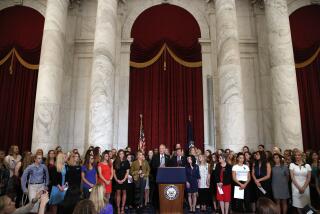Doubts Linger About Illinois’ Health Plan for Youths
When Gov. Rod Blagojevich signed it last fall, the All Kids legislation was heralded as one of the nation’s most ambitious plans to ensure that all children would have access to health insurance, regardless of their immigration status.
Now, as the program’s benefits have begun to roll out, thousands of families and doctors are wondering whether the broad-reaching effort will live up to its promise.
Illinois officials said the program, which launched July 1, was designed to cover medical, dental and vision visits as well as prescription drugs for those 18 and younger. It targets working-class families that can’t afford private insurance but earn too much to qualify for Medicaid.
New Mexico and Hawaii have established similar youth health benefits, and Massachusetts’ new near-universal program includes provisions to increase coverage for uninsured minors. Legislators in at least eight other states are examining proposals that would guarantee affordable coverage for minors.
And as the country heads into midterm elections, universal coverage for children has broad popular support: 83% of voters in California, for example, supported state proposals to make sure every child had health insurance, according to a recent poll conducted for the United Way.
“It’s more than just politics, though,” said Jocelyn Guyer, senior program director at the Center for Children and Families at Georgetown University’s Health Policy Institute. “Kids not having coverage is a huge problem, and it’s only getting bigger.”
The goal of All Kids is to fill the gap between where the federal government leaves off and where the private sector begins. An estimated 250,000 children in Illinois do not have health insurance.
So far, more than 43,000 children have been enrolled in All Kids; the state hopes to enroll 50,000 in the first year.
How much a family pays at the doctor’s office depends on its income. For example, a family of four that makes $40,000 to $60,000 a year would be billed a $10 co-payment for each doctor visit and $40 a month per child, according to program officials.
The program is to be funded by a combination of patient fees, federal funds and cuts to other state healthcare expenses.
Part of the costs will be covered by changing how the state’s 1.7 million Medicaid patients see their doctors. Instead of visiting any physician on a list, those beneficiaries will be assigned a single doctor -- a system modeled after health-management organizations.
“To me, healthcare is a fundamental human right,” Blagojevich said. “If it’s OK for the governor’s two young children to have regular visits to the doctors for checkups ... then the golden rule teaches us we should do for others as others would do for you.”
Yet some critics question whether All Kids, which is expected to cost $45 million in its first year, will be able to deliver on its promise. They fear the program could end up costing more than expected, which could strain an already tight state budget.
“We’ve seen lots of promises with All Kids and little else,” said state Sen. Peter Roskam (R-Wheaton), who has criticized the program’s design. “How much of this is politics, and how much of this is trying to do the right thing?”
Blagojevich, who has turned the program into a cornerstone of his reelection campaign this year, countered: “This is an affordable healthcare program, not a free one.”
Medical professionals have varying opinions about the program. Some are optimistic -- “It’s something we’ve needed for years,” said Dr. Mark Rosenberg, past president of the Illinois chapter of the American Academy of Pediatrics -- whereas others have serious concerns about the program’s long-term success.
“We have trouble with the state Medicaid program paying bills on time. We haven’t been told if patients are going to know where to go for treatment, or how we’re supposed to deal with referrals,” said Dr. Peter Eupierre, president of the Illinois State Medical Society. “There are too many unanswered questions for our comfort.”
Blagojevich said he spearheaded All Kids in response to appeals from voters, who said they could not afford regular medical checkups for themselves or their children, and couldn’t afford treatment if they got sick.
An estimated 46 million people in America lack health insurance, according to the U.S. Census Bureau, and some state and local governments are trying to step in and fill the gap.
In California, 18 of the state’s 58 counties are tapping a combination of private grants and local funds to run insurance programs for legal and undocumented minors. An additional 14 counties expect to launch similar programs in the next year.
In Los Angeles County, which runs the largest such program in the state, the demand is overwhelming: So many youths were enrolled that officials had to start a waiting list in 2005; the list was frozen this year.
As legislators move forward with their plans, analysts warn that such advances could be stalled next year when Congress reexamines the State Children’s Health Insurance Program. The plan provides states with grants to offer health coverage for children whose families do not qualify for Medicaid but can’t afford private health insurance.
“The federal government has tried to make cuts into Medicaid, and there’s concern that they’ll try to duplicate the same cuts here,” said Peter Harbage, an independent consultant and former assistant secretary with the California Health and Human Services Agency. “Without those federal dollars, these state programs will be in serious trouble.”
More to Read
Start your day right
Sign up for Essential California for news, features and recommendations from the L.A. Times and beyond in your inbox six days a week.
You may occasionally receive promotional content from the Los Angeles Times.






